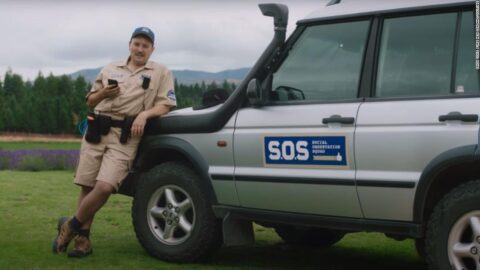(CNN) — Over the course of its long history, the Boeing 737 has acquired more nicknames than any other commercial aircraft.
Among them are Baby Boeing, Tin Mouse, Light Twin, Guppy, Bobby, Rudder Rotor, as well as a few less flattering ones, such as Fat Freddy and Dung Beetle.
But none of these is as notorious as Max, the name Boeing has given to the 737’s latest incarnation — now synonymous with disaster, as well as one of the worst corporate blunders of all time.
The problems that marred the 737 Max are intricately linked to the fact that the plane’s foundation is from the 1960s.
Over 50 years after its maiden flight, the Boeing 737 is both the most successful airliner ever made and one whose future is more uncertain than ever.
‘Profit-making machine’
The first 737 was rolled out on January 17, 1967 and took to the skies for the first time three months later. It was christened by flight attendants from the 17 airlines that had placed orders for it.
German flag carrier Lufthansa took delivery of the production version of the plane, known as the 737-100, later that year, marking the first time a new Boeing aircraft was launched by a European airline.
United Airlines received its first 737 the following day, in a version stretched three feet to fit more seats — and dubbed 737-200 — that proved more popular.
“Some of them were even used to land on gravel strips, and they’re still being used to do so in northern Canada.
“A few European charter companies, at peak season, flew them for 18-20 hours a day without problems,” he adds.
Compared to Boeing’s previous two jets, the four-engined 707 and the three-engined 727, the 737 was a smaller, more economical plane.
Its main competitors at the time, the BAC-111 and the Douglas DC-9, also had two engines, but they were placed near the tail of the plane, making the back section of the cabin narrower and noisier.
Boeing’s designers placed the 737 engines under the wing instead, much like the company’s other jets, which reduced noise and vibration and made maintenance easier, because they could be reached without a ladder.
Unlike Boeing’s larger planes, however, the 737 didn’t have its engines mounted on pylons in front of the wing, but directly under it. This allowed the aircraft to sit very low to the ground, making it easier to load luggage.
“You could load the plane from the back of a truck, without specific machinery. It was also easier to refuel, because the wings were lower to the ground,” says Simons.
“And it didn’t require external ladders for passenger access. Instead, it had air stairs that came out from under the door and dropped down. All of that could reduce the turnaround time at a major airport from around 90 to 40 minutes. A hell of a saving.”
To add to these selling points, the 737 also had six seats per row versus the competitors’ five, meaning it could carry more passengers.
“It became a very good profit-making machine,” says Simons.
Strong demand

The engines of the Boeing 737-300 have a flat-bottomed shape known as the “hamster pouch.”
MAURICIO LIMA/AFP via Getty Images
The 737 was Boeing’s first two-crew aircraft, doing away with the flight engineer station that was commonplace at the time and introducing another innovation that would become standard.
To demonstrate that the plane could be safely managed by just two pilots, Boeing flew it along the busy Washington-Boston corridor 40 times in six days during Thanksgiving 1967, simulating a range of failures and problems.
As a result, the FAA approved the plane for two-crew operation. Airlines, however, weren’t quick to adapt.
“At that time, pretty much every airliner had three crew; sometimes, on transatlantic flights, there were four crew: two pilots, a flight engineer and a navigator,” says Simons.
“But technology had evolved, and there was much more automatic equipment on the 737. On short flights, the work done by the flight engineer could be shared across the two pilots.
“A big saving for the airline: less weight to carry and one less wage to pay. Unions, however, didn’t like it.”
Pushback from unions slowed the acceptance of two-crew operation, and many airlines kept the flight engineer until the early 1980s.
This was one of the factors that slowed down the early commercial traction of the 737, and airlines initially operated the plane with three crew.
Its success came as a result of the plane’s first major redesign, which debuted with the 737-300 in 1984.
This model was longer and wider, with capacity for up to 150 passengers, and it was designed to stand up to its new rival, the European-made Airbus A320, which had launched the same year.
The 737-300 had a new, more modern engine that posed the first big challenge to Boeing’s engineers.
It was much bigger than the previous engine and wouldn’t fit under the wing, as the plane had been designed to be low to the ground.
The problem was solved by reducing the diameter of the fan and relocating engine components from the lower part of the pod to the sides. This gave it a distinct, flat-bottomed shape colloquially known as the “hamster pouch.”
The success of this upgrade set aside initial plans to design an entirely new, more modern aircraft to replace the 737, showing Boeing that results could be achieved by teaching its old dog new tricks.
First safety crisis
With the last delivery of a 737-200 in 1988, Boeing moved fully to the upgraded versions, which also included the 737-400 — the longest version yet, with a capacity of 188 passengers — and the smaller 737-500, a direct replacement of the 737-200 that was first flown by then fledgling Southwest Airlines.
Today, Southwest is the world’s largest 737 operator with 732 aircraft. It doesn’t fly any other airplane.
In both accidents, the rudder — a moving surface on the tail of the plane that affects its horizontal direction — started moving unexpectedly, causing the pilots to lose control of the plane.
While investigations were underway, another flight in 1996 almost crashed following similar problems with the rudder.
“Two serious accidents, three years apart. Very tragic, but it didn’t create the same crisis atmosphere back then, as the 737 Max accidents would,” says Simons.
Next Generation

At 138 feet, the 737-900ER is the longest 737 model so far, with capacity for up to 215 passengers.
Courtesy Boeing
By 1993, over 3,000 737s had been ordered, and about a quarter of those are still flying today.
That same year, Boeing announced the plane’s third redesign — called Next Generation — which would prove wildly popular and further cement the 737’s position as the world’s most successful airliner.
Working once again on the same airframe, to speed up certification and get the planes to airlines quickly, Boeing upgraded the plane’s wings, its fuel capacity, its engine, cockpit and interior, as well as increasing its takeoff weight.
Four variants were initially released (followed by several revisions), seating between 110 and 189 passengers.
The lineup included the longest 737 model to date, the 737-900ER, which at 138 feet was a full 44 feet longer than the original 737-100, and offered almost twice the range.
In total, the Next Generation family received over 7,000 orders, helping the 737 to become the first commercial aircraft to surpass 10,000 orders, in 2012.
By then, nearly a third of all commercial flights were operated by a 737, and one would take off or land somewhere in the world every two seconds.
During the rollout of this redesign, Boeing again started work on an all-new replacement for the now aging 737, a project codenamed Y1.
The idea was shelved once again, however, due to the success of yet another partial upgrade and the continued pressure from the fast-selling Airbus A320.
To the Max

The rollout of Boeing 737 MAX, the fourth generation of the Boeing 737, took place in 2016.
Courtesy Boeing
The Boeing 737 Max was announced in 2011, the fourth generation of the aircraft.
“Boeing needed to combat what Airbus were doing with the A320neo, a version of the plane with a new engine that was quite substantially more fuel efficient,” says Simons.
To do so, however, the company ran into a problem it had encountered before: the new, much bigger engines it wanted for the 737 Max wouldn’t fit under the plane’s low wings — an issue Airbus didn’t have, because the A320 was already a much taller plane than the 737.
The solution was to add some length to the front landing gear and mount the engines further forward and higher on the wings, giving them the clearance they needed.
But, as Boeing later found out in simulators, this altered the plane’s aerodynamics, making it tilt up dangerously in certain situations.
To counter the problem, the company devised a safety system called MCAS, which would immediately push the 737’s nose down if it tilted too high.
Because MCAS was designed to make the 737 Max fly just like previous 737s, and because Boeing believed that it would come into action only in extreme flying circumstances, it was kept almost secret.
Boeing decided against including it in the brief lesson that pilots already certified for previous 737s needed to take to fly the 737 Max.
Furthermore, MCAS relied on a single sensor, a heresy in aviation where redundancy is always preferred.
Airlines liked the 737 Max, because it was more economical to operate and didn’t require expensive simulator training for their pilots.
The plane’s four variants offered several other improvements, including capacity up to 204 passengers, longer range, and distinctive split-tip winglets at the tip of each wing as standard, to further increase fuel efficiency.
It would go on to surpass 5,000 orders, bringing the total orders to date for the 737 line to more than 16,000, before disaster struck.
Global grounding

Boeing 737 MAX — the fourth generation of the Boeing 737 — has been grounded since 2019.
Courtesy Boeing
Two fatal accidents, both involving 737 MAX 8 variants, occurred on October 29, 2018 and on March 10, 2019.
Both times, MCAS incorrectly activated due to erroneous data from a faulty sensor, and pitched the nose of the plane down.
The pilots didn’t know how to react, and desperately tried to lift the plane’s nose, but MCAS activated again and again, eventually diving the planes into the ground.
A combined 346 people died aboard those two flights. A few days after the second accident, once the similarities with the first became obvious, Boeing grounded the entire 737 Max fleet.
“In my view, the Max was a series of modifications too far. They should have never come out with it in the first place. They should have sat down with a blank computer screen to design an entirely new aircraft,” says Simons.
Already on its knees from the pandemic, the aviation industry still awaits the final verdict on the 737 Max saga.
In the meantime, however, production of the plane stopped for months and hundreds of orders have been canceled.
It remains to be seen whether Boeing will even keep calling the plane Max or rebrand it altogether, and whether the public will show a distrust of the aircraft to the point of explicitly avoiding it.
But will it be safe to fly on a 737 Max? No doubt, according to Simons.
“None of the aviation authorities around the world are going to take a gamble of clearing the aircraft to fly, if they haven’t tested it thoroughly,” he adds.
“They are probably going to do way more testing that is realistically needed. They’re going to make 100% sure that it is safe to fly.”








Recent Comments